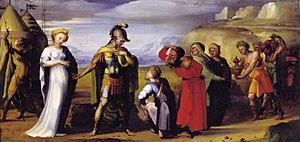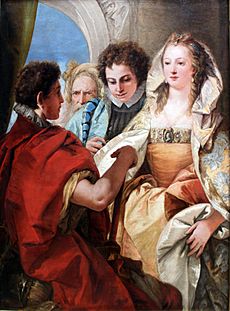The Continence of Scipio facts for kids

The Continence of Scipio is a famous story about the Roman general Scipio Africanus. It shows how he was kind and fair during a war. The story was first told by the historian Livy. During the Second Punic War, Scipio was fighting in Spain. He captured a young woman but refused to take money for her release. Instead, he returned her to her fiancé, Allucius. Because of Scipio's kindness, Allucius became a strong supporter of Rome. This act of mercy was seen as a great example of how a leader should behave. The story became very popular again during the Renaissance and was featured in many books, artworks, and operas.
Contents
The Story from Ancient Times
The oldest version of this story comes from a book called Ab urbe condita by the Roman historian Livy. This book describes events from ancient Rome.
Livy tells us about the siege of New Carthage in Spain in 209 BC. Roman forces, led by Publius Cornelius Scipio, attacked this city. Scipio later became known as Scipio Africanus. A local prince named Allucius, who was an ally of Carthage, was engaged to a beautiful young woman. She was captured by Scipio's soldiers during the battle.
Scipio had a reputation, so his soldiers brought the woman to him. But when Scipio learned she was engaged, he called her parents and fiancé. They arrived with a lot of treasure, offering it as a payment to free her. Scipio refused the money. Instead, he offered to return the woman to Allucius if Allucius would become a friend to Rome.
The family then offered the treasure as a gift to Scipio. He accepted it, but then immediately gave it back to them as a wedding gift for the couple. Allucius was so grateful that he and his tribe joined forces with Rome. They helped the Roman armies in the war.
The Story in Later Times
Starting in the Renaissance, the story of Scipio's kindness became very popular. It was used as an example of good behavior. Its popularity grew a lot in the 1600s and 1700s.
Books and Operas
Many writers and composers used Scipio's story. For example, in 1567, Carolus Clusius added the story to his translation of Plutarch’s Lives. Plutarch had not included it, but Clusius thought it was important.
Plays were also written about Scipio. Scipion by Jean Desmarets (1638) was one such play. It was even adapted into Dutch. In England, a young student named Charles Beckingham wrote a play called Scipio Africanus in 1718.
Many operas were also created based on the story. An opera is a play set to music. Different composers often used the same story (called a libretto) for their operas. For example, Nicolo Minato's Scipione Africano was set to music by several composers, including Francesco Cavalli (1662) and Francesco Bianchi (1787). George Friederic Handel also created an opera called Scipione in 1726, based on a story by Apostolo Zeno.
Artworks

Many artists painted scenes of Scipio showing mercy. These paintings have different titles, like "The Continence of Scipio" or "The Clemency of Scipio." Sometimes, it can be hard to tell if a painting is about Scipio or another famous general, Alexander the Great. Alexander also showed kindness to prisoners. Both stories often show a victorious general sitting on a throne with people kneeling before him.
Usually, in paintings of Scipio, he is seated on a raised platform. He reaches out his arm towards the Spanish people, who have their treasure laid out in front of them.
The story was also popular for tapestry series. These were large woven pictures that told a story. Sometimes, the artworks were connected to marriage. For example, a 15th-century painted panel on a marriage chest showed Scipio's story. This was because the wedding between Allucius and his bride happened right after she was returned to him.
Many paintings of Scipio's act of kindness were made across Europe. Some artists painted the subject more than once. For example, Frans Francken the Younger painted eight versions of the scene. Peter Paul Rubens also painted two versions, though they were later destroyed.
Images for kids
See also
 In Spanish: La clemencia de Escipión para niños
In Spanish: La clemencia de Escipión para niños




